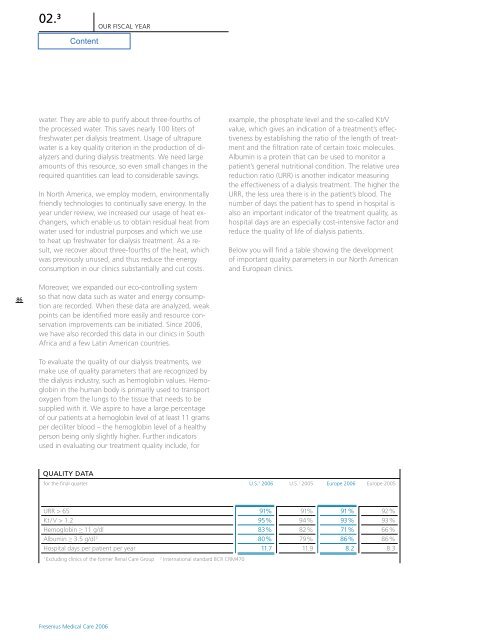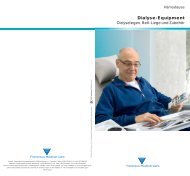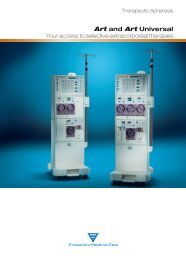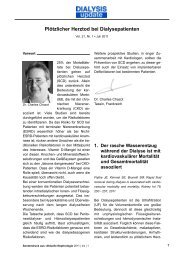Operations and Business Environment - Fresenius Medical Care
Operations and Business Environment - Fresenius Medical Care
Operations and Business Environment - Fresenius Medical Care
Create successful ePaper yourself
Turn your PDF publications into a flip-book with our unique Google optimized e-Paper software.
02. 3<br />
Our Fiscal year<br />
water. They are able to purify about three-fourths of<br />
the processed water. This saves nearly 100 liters of<br />
freshwater per dialysis treatment. Usage of ultrapure<br />
water is a key quality criterion in the production of dialyzers<br />
<strong>and</strong> during dialysis treatments. We need large<br />
amounts of this resource, so even small changes in the<br />
required quantities can lead to considerable savings.<br />
In North America, we employ modern, environmentally<br />
friendly technologies to continually save energy. In the<br />
year under review, we increased our usage of heat exchangers,<br />
which enable us to obtain residual heat from<br />
water used for industrial purposes <strong>and</strong> which we use<br />
to heat up freshwater for dialysis treatment. As a result,<br />
we recover about three-fourths of the heat, which<br />
was previously unused, <strong>and</strong> thus reduce the energy<br />
consumption in our clinics substantially <strong>and</strong> cut costs.<br />
example, the phosphate level <strong>and</strong> the so-called Kt/V<br />
value, which gives an indication of a treatment’s effectiveness<br />
by establishing the ratio of the length of treatment<br />
<strong>and</strong> the filtration rate of certain toxic molecules.<br />
Albumin is a protein that can be used to monitor a<br />
patient’s general nutritional condition. The relative urea<br />
reduction ratio (URR) is another indicator measuring<br />
the effectiveness of a dialysis treatment. The higher the<br />
URR, the less urea there is in the patient’s blood. The<br />
number of days the patient has to spend in hospital is<br />
also an important indicator of the treatment quality, as<br />
hospital days are an especially cost-intensive factor <strong>and</strong><br />
reduce the quality of life of dialysis patients.<br />
Below you will find a table showing the development<br />
of important quality parameters in our North American<br />
<strong>and</strong> European clinics.<br />
86<br />
Moreover, we exp<strong>and</strong>ed our eco-controlling system<br />
so that now data such as water <strong>and</strong> energy consumption<br />
are recorded. When these data are analyzed, weak<br />
points can be identified more easily <strong>and</strong> resource conservation<br />
improvements can be initiated. Since 2006,<br />
we have also recorded this data in our clinics in South<br />
Africa <strong>and</strong> a few Latin American countries.<br />
To evaluate the quality of our dialysis treatments, we<br />
make use of quality parameters that are recognized by<br />
the dialysis industry, such as hemoglobin values. Hemoglobin<br />
in the human body is primarily used to transport<br />
oxygen from the lungs to the tissue that needs to be<br />
supplied with it. We aspire to have a large percentage<br />
of our patients at a hemoglobin level of at least 11 grams<br />
per deciliter blood – the hemoglobin level of a healthy<br />
person being only slightly higher. Further indicators<br />
used in evaluating our treatment quality include, for<br />
Quality data<br />
for the final quarter U.S. 1 2006 U.S. 1 2005 Europe 2006 Europe 2005<br />
URR > 65<br />
Kt / V > 1.2<br />
Hemoglobin ≥ 11 g/dl<br />
Albumin ≥ 3.5 g/dl 2<br />
Hospital days per patient per year<br />
91%<br />
95 %<br />
83 %<br />
80 %<br />
11.7<br />
91%<br />
94 %<br />
82 %<br />
79 %<br />
11.9<br />
91 %<br />
93 %<br />
71 %<br />
86 %<br />
8.2<br />
92 %<br />
93 %<br />
66 %<br />
86 %<br />
8.3<br />
1<br />
Excluding clinics of the former Renal <strong>Care</strong> Group<br />
2<br />
International st<strong>and</strong>ard BCR CRM470<br />
<strong>Fresenius</strong> <strong>Medical</strong> <strong>Care</strong> 2006








